
U.S. WEAPONS: INSTRUMENTS OF THE DESTRUCTION
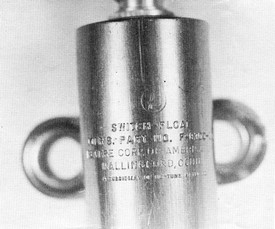
Part of carburator attached to F-15 tank
|
F-15 IN COMBAT MISSION
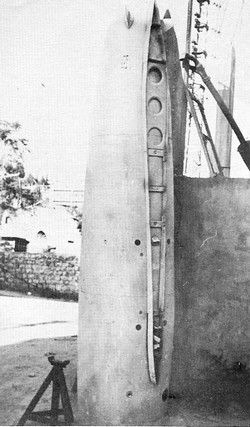
Extra fuelage tank released by U.S.-Israeli
F-15 near the town of Nabatiyeh/South Lebanon, during dog fight with Syrian planes on July 22, 1979 |
Therefore, when the Israelis used U.S. Phantoms in an August 20 air raid against the village of Ras al Ain and other targets in South Lebanon, the State Department proclamation that the U.S. "did not know" if the planes were U.S.-made, is a case of voluntary blindness. On the level of U.S. intelligence reports alone, it is impossible to believe that the U.S. government has been left so conveniently in the dark. In addition, sources at Ras al Ain report that U.S.-supplied cluster bombs, anti-personnel weapons, were used in the August 20 attack.
U.S. LONG-RANGE ARTILLERY, FRAGMENTATION SHELLS
The use of U.S.-made 155, 175 and 203 mm artillery against South Lebanon in late August is also well documented. Washington Post reporter Ed Cody reported on August 30 from Tyre that a "fierce artillery barrage" on August 24 sent "155 and 175 mm shells crashing into homes and shops." Also on August 30, a Palestinian spokesman in Beirut showed journalists all three kinds of shells, which had recently been brought from Tyre. In fact, the targets hit in the August attacks speak for themselves: the artillery shelling against Sidon on August 22 and 23 and on the Beqaa Valley on August 22 could only have been carried out by U.S.-supplied long-range artillery.
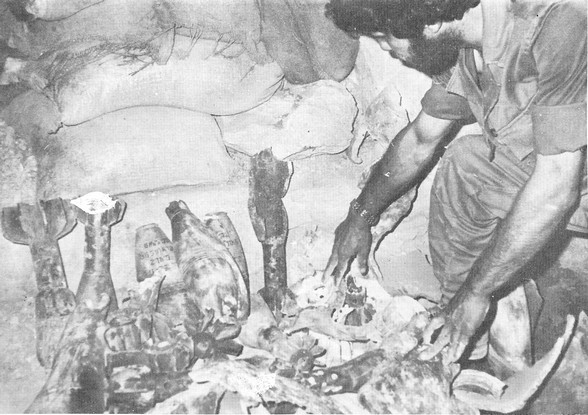
Remnants of U.S. and Israeli shells collected near Arnoun (right: remnants of 210 pound U.S. air-to-ground rocket)
|
This long-range artillery is used to carry both time-delayed and fragmentation shells, both of which have been used frequently in South Lebanon. Time-delayed bombs, which were reported in Tyre by Agence France Presse in August, have their fuse set for some time after impact, so they explode as people leave shelters to inspect the damage.
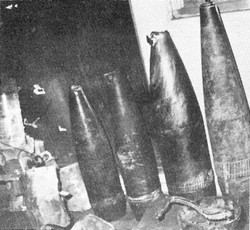
Unexploded shells used recently against town
of Tyre (right: U.S.-made 175 mm shell; second from right: U.S.-made 203 mm shell) |
ISRAELI ARMS CANNOT BE SEPARATED FROM U.S.
It should also be noted that the growing Israeli arms industry cannot be separated from the U.S. Not only are many weapons manufactured under U.S. license, but many parts of these "Israeli" weapons are U.S.-supplied. The Israeli Kfir fighter plane, for example, is equipped with a U.S. C-130 engine, which was sold to the Israelis under the condition it be used only for "defensive" purposes. Financing, of course, both directly and indirectly, comes from the U.S. On September 14, Defense Minister Ezer Weizman will arrive in Washington to discuss joint U.S.-Israeli production of F-16 and F-18 fighter aircraft with Defense Secretary Harold Brown.
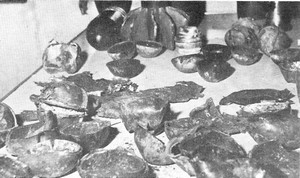
U.S.-made anti-personnel cluster bombs, used again in
early August 1979 during Israeli air raid on Ras al-Ain/ South Lebanon |
PROMINENT AMERICANS SLAM U.S. "IGNOBLE ROLE"
Former United States Attorney-General Ramsey Clark said on August 29, 1979, the United States should warn Israel that it would cut off the supply of American arms unless Israel stopped using them to attack South Lebanon. Clark, recently returned from a visit to the area, said he saw enormous damage as a result of indiscriminate air and artillery attacks.
"The U.S. role has been ignoble. We have supplied the instrumentalities of destruction. We have seen the same bomb casings as in Vietnam," he told a press conference. Clark, who campaigned against the Vietnam war, said he would "like to be able to love Israel and still love justice." The U.S. finally had to decide whether it stood for law and principle in Lebanon, he said. It should tell the Israeli government that "if the use of our material does not cease immediately, they should cease the delivery of further material."
Clark said his trip was under the auspices of the United Methodist Office of the United Nations, which monitors activities at the world organization. He was accompanied by Dave Dellinger, editor of the publication Seven Days, Fred Jameson, a Yale professor, and Don Luce, co-ordinator of the Asian Center. During the tour, the four met with Palestine Liberation Organization head Yasser Arafat, Lebanon's Prime Minister Selim Hoss, religious leaders and villagers.
Dellinger said the tour of the ruins of Southern Lebanon reminded him of his 1966 visit to North Vietnam. He said that on both trips, he saw numerous schools, hospitals and churches that had been hit, even though it was claimed the bombs were only directed at military targets. Dellinger said he believed the Israeli bombings have forced 500,000 to one million people in Lebanon to flee their homes.
Contact us: New Jersey Solidarity - Activists for the Liberation of Palestine
(973) 954-2521
info@newjerseysolidarity.org
http://www.newjerseysolidarity.org
New Jersey Solidarity
344 Grove Street, Suite 131
Jersey City, NJ 07302